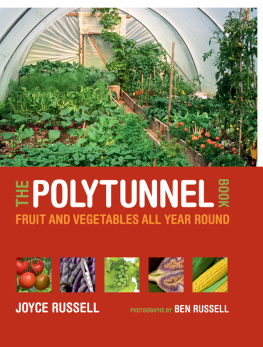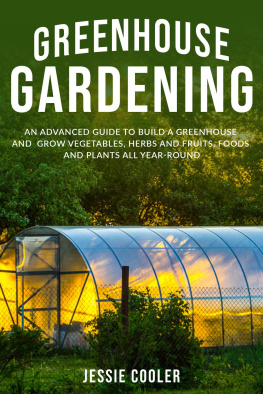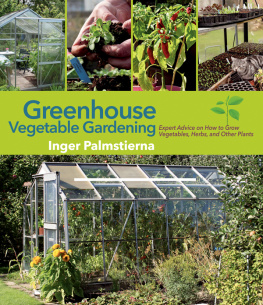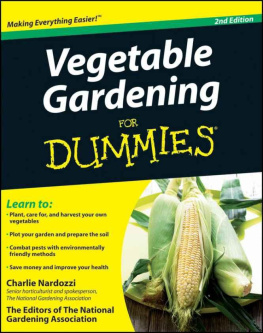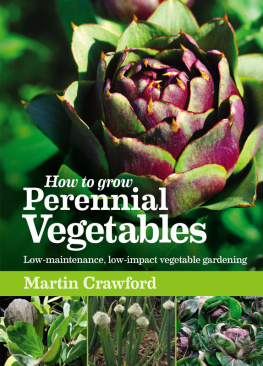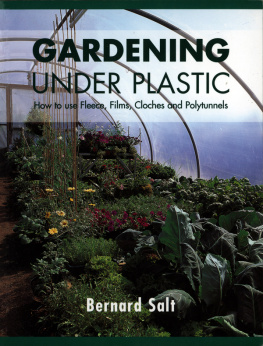THE POLYTUNNEL BOOK
FRUIT AND VEGETABLES ALL YEAR ROUND

THE POLYTUNNEL BOOK
FRUIT AND VEGETABLES ALL YEAR ROUND
JOYCE RUSSELL
PHOTOGRAPHS BY
BEN RUSSELL

INTRODUCTION
I bought a polytunnel about sixteen years ago. It seemed like a major investment at the time and, with a large garden already growing a wide range of crops, I wasnt sure how much use it would be. By the first summer I was so passionate about polytunnel growing that when winter came along I simply couldnt stop. Boundaries have to be pushed, and I wanted to see if it would be possible to keep the polytunnel cropping all year round. In the years since then, I have lost none of that passion. Ive learned more and more about how to make an ordinary-sized polytunnel provide enough food to keep a family eating through winter and summer alike; and Ive enjoyed, every day, excellent fruit and vegetables that have to travel only a few strides from the plant to the plate.
A polytunnel is a wonderful thing! It costs a fraction of the price of a traditional glass greenhouse and its put up quickly to cover a large space. It provides a warmer environment than the great outdoors; it blocks wind and shelters from rain. Tender crops that would have difficulty growing outside thrive in it and the gardener thrives too when working in, and reaping the rewards of, such a protected space.

Maybe enthusiasts tend to go on about their passions, but at least I found an outlet for mine over the years in writing features for garden magazines. Gardeners are inventive people. They are people who like to do the best they can with whatever resources come to hand. But most of all they like to share their tips (and their problems) and to encourage new growers to become part of the gardening clan.
This book is born of a need to share. Its born of readers asking when Im going to put a book together to save them time hunting through back issues of magazines. Its also born of the questions of my gardening friends, who phone or email at regular intervals to ask: Is it time to sow basil? My cucumber plants have flopped. What can I do? Or, most of all: What should I be doing in the polytunnel now?
That last question was my starting point. This book is designed to provide some answers as it guides the reader through the growing year in an unheated polytunnel. I hope it also inspires people to experiment and to continue the tradition of sharing their tips, troubles and triumphs with other gardeners. But most of all, I hope this book helps readers to develop a passion for growing great polytunnel crops.
HOW TO USE THIS BOOK
Theres a lot of information contained within these pages. Some of this will be more suited to the beginner grower and some will be more appropriate for the experienced gardener. Flick through the pages and get a feel for things. Learn how to use the book, so that it gives you what you want. And dont worry if it gets a little grubby from constant use.
PART 1

explains how to choose, put up and lay out a polytunnel. It also tackles the issue of planning permission. In all cases, this section is only a guide. Its always best to ask the experts if you can. Each individual manufacturer will give the best instructions for their own particular structure and some of these will put it up for you if you want.
PART 2

lists some tools and supplies that you might find useful.
PART 3

is a month-by-month guide to polytunnel growing. Each month has a list of jobs that can be done. Theres also a list of fruit, vegetables or herbs that can be sown. These are suggestions and the text for each month gives more detail and a scattering of interesting tips. Its probably best to read the bit about sowing carrots in January if its the first time youve considered making such an early sowing. If youve made similar sowings in previous years, however, the list might be enough to act as a memory prod.
PART 4

gives an at a glance overview of each of the main fruits and vegetables that can be grown in a polytunnel. If you want a quick reminder of the planting distance for aubergines, or when to reduce watering for pepper plants, this is the place to look. If you want to know more, this section will refer you to the relevant month.
PART 5

deals with pests and diseases. If theres a problem in the polytunnel, look here to find out what it might be. Dont despair! There are always solutions to problems and this section can help you negotiate the worst pitfalls.
PART 6

goes a little beyond the immediacy of month-by-month growing and looks at the overall plan. Get crop rotations organized, look after the soil and look after the structure of the polytunnel, and you should grow great crops for years to come.
PART 7
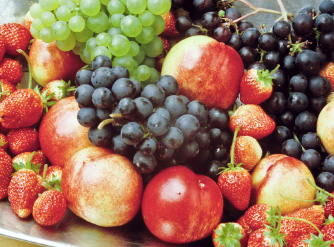
is for those who like to make their own if they possibly can. There are recipes for potting compost, as well as how to set up a hotbed and how to make liquid feeds.
The list of suppliers shows just how easy it is to find someone to sell you a polytunnel, or seeds, or the pots, feeds and biological pest controls that can make it all come together as a perfectly functioning system.
Top Tip
Get sowing, get growing, but most of all enjoy the delights of producing fruit and vegetables in a polytunnel all year round.
SETTING UP A POLYTUNNEL

CHOOSING THE RIGHT LOCATION
If there is only one place where the polytunnel will fit in the garden, thats where it goes and you have to cope with any faults of the site. If there is a choice, however, its worth considering a few factors before settling on the final position.
How visible will the polytunnel be?
Polytunnels arent beautiful things. If you have the option of putting one where it is hidden from view, this makes a lot of sense. Bear in mind that neighbours dont want it blocking a view any more than you do. Polytunnels come in different heights a low one may be more discreet than a taller one.
How close to the house?
Next page
